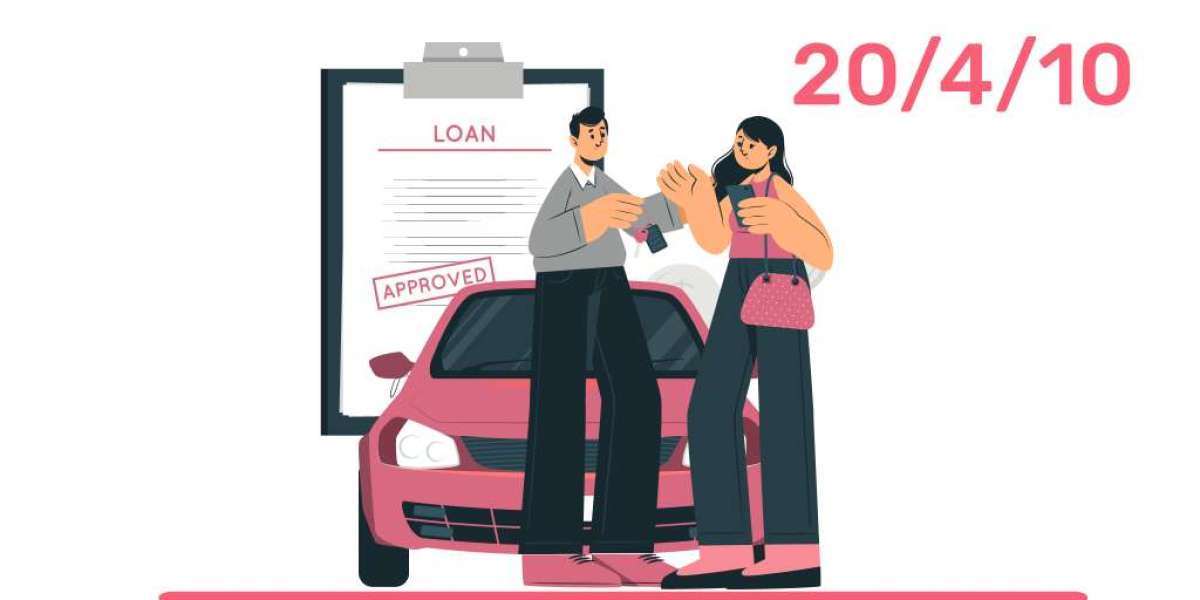Buying a car is a significant financial decision that requires careful planning and consideration. One popular method to ensure you make a wise choice is the 20/4/10 rule. This rule provides a simple framework for budgeting your car purchase. In this comprehensive guide, we'll explore the 20/4/10 rule for buying a car in detail. We'll discuss its components, benefits, and how to apply it effectively.
Understanding the 20/4/10 Rule
The 20/4/10 rule is a straightforward guideline for car buyers to follow. It consists of three main components:
20% - Make a down payment of at least 20% of the car's value.
4 - Limit the loan term to no more than 4 years.
10 - Keep your total monthly vehicle expenses under 10% of your gross income.
Now, let's break down each component and explore why they're important.
The 20% Down Payment
Making a substantial down payment is crucial when purchasing a car. Here's why the 20% rule matters:
- Reduces the loan amount
- Lowers monthly payments
- Decreases interest paid over the life of the loan
- Protects against depreciation
- Improves your chances of loan approval
A 20% down payment may seem challenging, but it offers significant benefits. It helps you avoid being "underwater" on your car loan. This term refers to owing more on the car than it's worth. By making a larger down payment, you start with positive equity in the vehicle.
Moreover, a bigger down payment can lead to better loan terms. Lenders view borrowers who make substantial down payments as less risky. Consequently, you may qualify for lower interest rates and more favorable loan conditions.
The 4-Year Loan Term
Limiting your car loan to four years or less is the second component. Here's why this rule is beneficial:
- Reduces total interest paid
- Builds equity faster
- Aligns loan term with the vehicle's useful life
- Encourages purchasing within your means
- Provides flexibility for future financial decisions
Shorter loan terms mean higher monthly payments but less overall interest. You'll pay off your car faster and own it outright sooner. This approach helps you avoid the trap of perpetual car payments.
Additionally, a four-year term aligns better with most vehicles' depreciation curves. Cars typically lose value quickly in the first few years. By paying off your loan in four years, you're less likely to owe more than the car is worth.
The 10% Monthly Expense Limit
The final component of the 20/4/10 rule focuses on affordability. Here's why limiting your monthly vehicle expenses to 10% of your gross income is important:
- Ensures the car fits your budget
- Leaves room for other financial priorities
- Reduces financial stress
- Helps maintain a healthy debt-to-income ratio
- Allows for savings and investments
This 10% limit includes more than just your car payment. It encompasses all vehicle-related expenses, such as:
- Monthly loan payment
- Insurance premiums
- Fuel costs
- Maintenance and repairs
- Parking fees or tolls
By adhering to this guideline, you ensure that your car doesn't become a financial burden. It allows you to maintain a balanced budget and pursue other financial goals.
Applying the 20/4/10 Rule in Practice
Now that we understand the components, let's explore how to apply this rule. Here's a step-by-step guide to using the 20/4/10 rule for your car purchase:
- Calculate your gross monthly income
- Determine 10% of your gross monthly income
- Subtract estimated insurance, fuel, and maintenance costs from this amount
- The remaining figure is your maximum monthly car payment
- Use an auto loan calculator to determine your maximum car price
- Save for a 20% down payment on this maximum price
- Shop for cars within your calculated price range
- Negotiate for a four-year loan term or less
Remember, these are maximum guidelines. It's often wise to aim for less expensive options. This approach provides more financial flexibility and security.
Benefits of Following the 20/4/10 Rule
Adhering to the 20/4/10 rule offers numerous advantages. Here are some key benefits:
- Financial stability: You're less likely to overextend yourself financially.
- Lower overall costs: You'll pay less in interest over the life of the loan.
- Positive equity: You're more likely to owe less than the car is worth.
- Improved credit score: Timely payments on a manageable loan can boost your credit.
- Reduced stress: You'll have peace of mind knowing your car fits your budget.
- Future flexibility: You'll be in a better position for future financial decisions.
By following this rule, you set yourself up for long-term financial success. It helps you avoid common pitfalls associated with car buying and financing.
Challenges in Following the 20/4/10 Rule
While the 20/4/10 rule offers many benefits, it can be challenging to follow. Here are some common obstacles:
- Saving for a 20% down payment
- Finding affordable cars that meet your needs
- Resisting the temptation of longer loan terms
- Balancing car expenses with other financial priorities
- Dealing with unexpected changes in income or expenses
Despite these challenges, the rule remains a valuable guideline. It encourages responsible car buying and financial planning. With some effort and discipline, most people can successfully apply this rule.
Alternatives to the 20/4/10 Rule
While the 20/4/10 rule is popular, it's not the only approach. Here are some alternative guidelines:
- The 20/10/4 rule: Similar, but emphasizes a shorter loan term.
- The 36% rule: Limits all debt payments to 36% of gross income.
- The 50/30/20 budget: Allocates income to needs, wants, and savings.
- The 20% rule: Limits car expenses to 20% of take-home pay.
These alternatives offer different perspectives on budgeting for a car purchase. Choose the method that best fits your financial situation and goals.
Tips for Successful Car Buying
Beyond the 20/4/10 rule, here are additional tips for smart car buying:
- Research thoroughly before shopping
- Get pre-approved for a loan
- Consider certified pre-owned vehicles
- Negotiate the total price, not just monthly payments
- Be prepared to walk away from a bad deal
- Read all paperwork carefully before signing
- Consider the total cost of ownership, not just the purchase price
- Avoid unnecessary add-ons and extended warranties
- Shop around for the best insurance rates
- Plan for regular maintenance to protect your investment
These tips, combined with the 20/4/10 rule, can help you make a wise car purchase.
When to Bend the Rules?
While the 20/4/10 rule is a solid guideline, there may be times to deviate. Here are some situations where flexibility might be necessary:
- When you need a specific vehicle for work or family needs
- If you're in a temporary financial situation that will improve soon
- When interest rates are exceptionally low
- If you're purchasing a highly reliable vehicle with a longer expected lifespan
- When you have significant savings or investments to fall back on
Remember, rules are guidelines, not absolute laws. Use your judgment and consider your unique circumstances.
The Impact of the 20/4/10 Rule on Your Financial Future
Following the 20/4/10 rule can have far-reaching effects on your finances. Here's how:
- Improved cash flow: Lower car payments mean more money for other goals.
- Better retirement savings: You can invest more when you're not overspending on cars.
- Increased net worth: You'll build equity faster and avoid depreciation losses.
- Enhanced financial habits: The discipline learned can apply to other areas.
- Reduced financial stress: A manageable car payment contributes to overall well-being.
By making smart car buying decisions now, you set yourself up for future success.
Common Mistakes to Avoid
Even with guidelines like the 20/4/10 rule, people often make car buying mistakes. Here are some to avoid:
- Focusing solely on monthly payments
- Neglecting to factor in insurance and maintenance costs
- Falling for dealership tricks and unnecessary add-ons
- Skipping the test drive or mechanical inspection
- Not shopping around for the best loan rates
- Overestimating your ability to afford a luxury vehicle
- Ignoring the importance of a good credit score
- Failing to read and understand the fine print
- Rushing into a purchase without proper research
- Letting emotions override logical decision-making
Avoiding these pitfalls will help you make a more informed and financially sound decision.
The Role of Technology in Car Buying
Modern technology has transformed the car buying process. Here's how it can help:
- Online research tools provide extensive vehicle information
- Comparison websites allow you to shop multiple dealerships
- Loan calculators help you apply the 20/4/10 rule accurately
- Budgeting apps assist in tracking your car expenses
- Online reviews offer insights into vehicle reliability and performance
Leverage these tools to make the car buying process easier and more informed.
The Future of Car Buying and Financing
The automotive industry is constantly evolving. Here are some trends that may impact future car buying:
- Increased focus on electric and hybrid vehicles
- Growth of car subscription services
- Expansion of online car buying platforms
- Development of self-driving technology
- Changes in urban transportation needs
While these trends may change how we buy cars, financial prudence will always be important.
Conclusion: Driving Towards Financial Success
The 20/4/10 rule provides a solid framework for responsible car buying. By making a 20% down payment, limiting your loan to four years, and keeping total car expenses under 10% of your income, you set yourself up for financial success. This approach helps you avoid common car buying pitfalls and ensures your vehicle fits comfortably within your budget.
Remember, buying a car is more than just a transportation decision. It's a significant financial commitment that can impact your long-term financial health. By following the 20/4/10 rule and the additional tips provided, you can navigate the car buying process with confidence.
Ultimately, the goal is to find a balance between your transportation needs and your financial well-being. The 20/4/10 rule helps you achieve this balance, allowing you to enjoy your vehicle without undue financial stress. Whether you're a first-time car buyer or a seasoned owner, these guidelines can help you make a smart, sustainable car purchase.
As you embark on your car buying journey, keep the 20/4/10 rule in mind. It's a powerful tool that can guide you towards a decision you'll be happy with for years to come. Happy car shopping, and here's to your financial success!









